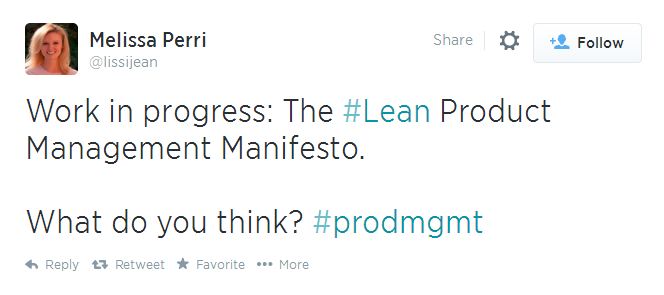by Saeed Khan
First of all, thanks to Tina Turner for inspiration for the title of this post. 🙂
Second, this post is my response to the following tweet by Melissa Perri (@lissijean). I don’t know Melissa, and I have nothing against her in any way, so my post should simply be viewed as a response to the idea and not directed at her personally. 
The manifesto itself – a work in progress – is structured in a form similar to the Agile Manifesto. e.g.
1. Focusing on customer problems over focusing on features
2. Problem exploration over gathering requirements
3. Small rapid experiments over large feature specs
4. Building roadmaps to reflect experiments and goals over building roadmaps to schedule work etc.
My response:  (click to enlarge)
(click to enlarge)
So first, mea culpa, I called it the “agile” manifesto, when it is actually the “lean” manifesto. Honest mistake, though you may be able to see why. So here’s why I’m not a fan.
What problem is it solving?
In a somewhat ironic reference to the first line of the manifesto, I wonder:
“Before listing out various statements, what problem is this manifesto looking to solve?”
I think this is critical to any definition process, particularly a collaborative one. Additionally, as Product Managers, shouldn’t this be the initial focus? A manifesto is a statement of intentions, motives or views.It is often a call for change to a situation or condition that has become problematic or untenable.
The US Declaration of Independence is one of the most famous manifestos ever published. Ironically, another very famous manifesto is the Communist Manifesto, written by Karl Marx and Friedrich Engels.
A more recent manifesto, the Peanut Butter Manifesto, was a call for change within Yahoo to address the malaise that one executive viewed as a core problem. What core problem needs to change for Product Management?
Why the focus on Lean?
This is the “Lean Product Management Manifesto”. Is this a manifesto for Lean Product Management, or is it a Lean Manifesto for Product Management?
I’m being a bit facetious here, but why not simply call it the Product Management Manifesto? I don’t want to assume I know Melissa’s intentions, but the word “Lean” is troublesome for me.
I’ve seen people put words like Lean, Agile and Extreme in front of “Product Management” to associate with some au courant methodology. When Agile was all the rage (it still may be though cracks are showing), and everyone was talking about “Agile Product Management”, I wrote a number of posts counter to the trend, including one entitled Product Management has always been Agile.
The point was that, development methodologies will come and go, but Product Management must rise above the product implementation process, both by definition and practicality.
As an aside — and again not asserting anything about Melissa’s intention — this recurring attempt to associate Product Management with specific development practices, e.g Lean, Agile etc., shows a lack of clarity on what Product Management is. It’s much broader than the Development process. It also possibly shows an inferiority complex. e.g. the Agilists are getting all the attention, so let’s associate and get some of that mojo!
Why the “me-too” format?
The format — <Action/Noun A> over <Action/Noun B> — is clearly borrowed from the Agile Manifesto. Perhaps this was the reason that I inadvertently tweeted it as the #agile #prodmgmt manifesto.
The Agile Manifesto is, if nothing else, a wonder of brevity. In very few words, it manages to define and propose a significant shift in how software projects would progress. The people behind the Agile Manifesto had a clear set of problems they were trying to address and chose a very clever and distinct format for their manifesto.
I like the Agile Manifesto as much (or more) for it’s form as for what it says, though the extreme brevity has caused problems as there is clearly a lot of context that is essential for understanding Agile that is completely ignored by many.
Borrowing the Agile Manifesto’s format for a Lean Product Management Manifesto has clear problems that will likely cause confusion. Why not apply some Product Management fundamentals to the Product Management Manifesto?
Say what needs to be said in a distinct format that is best suited to the problem at hand. This will help differentiate and position that manifesto as something that stands alone, and is not a derivative of something else, particularly a problematic software development manifesto.
We need discussion over declarations
Let me say that I see value in the discussion that Melissa has generated. There is a lot of confusion and misinformation about Product Management, even amongst Product Managers themselves. Check out this LinkedIn discussion — you may need to join the group. Over 350 VERY different responses to the question:
What exactly do you do here? What is your one line answer as a Product Manager?
Here’s one of the more unique responses. 🙂
“Translate ‘techno’ into ‘buzzo’ for the marketers and ‘buzzo’ into ‘techno’ for the engineers — someone has to do it!”
 There were some other strange responses, and the sheer variety indicates there is significant room for improvement. If Product Managers can’t come up with some good definitions of what they do, how would anyone else?
There were some other strange responses, and the sheer variety indicates there is significant room for improvement. If Product Managers can’t come up with some good definitions of what they do, how would anyone else?
High-tech product management is a VERY young profession; maybe 30 or so years old. I call Intuit’s founder Scott Cook the first true high-tech product manager. So there is a lot of work still to do.
Do we need another manifesto? No. But perhaps the discussion that Melissa has started will move things forward. It certainly inspired me to write this blog post. 🙂
Saeed
P.S. Back in 2009, I also thought about defining a PM Manifesto, but decided not to pursue it after I thought through the problem and the best solution. The blog posts are still there for those who care to read what I wrote back then.
Tweet this: We don’t need another Manifesto #prodmgmt http://wp.me/pXBON-4a1
About the Author
 Saeed Khan is a founder and Managing Editor of On Product Management, and has worked for the last 20 years in high-technology companies building and managing market leading products. He also speaks regularly at events on the topic of product management and product leadership. You can contact him via Twitter @saeedwkhan or via the Contact Us page on this blog.
Saeed Khan is a founder and Managing Editor of On Product Management, and has worked for the last 20 years in high-technology companies building and managing market leading products. He also speaks regularly at events on the topic of product management and product leadership. You can contact him via Twitter @saeedwkhan or via the Contact Us page on this blog.